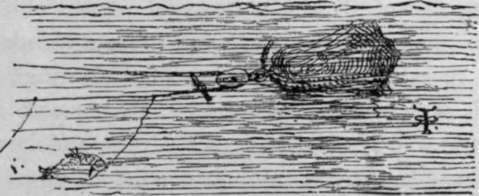Float. Part 6
Description
This section is from the book "Sea Fishing", by John Bickerdyke. Also available from Amazon: Sea Fishing.
Float. Part 6
Where there is a considerable rise of tide, a very long line is of course required ; in fact, this tackle is not suitable for places where the tide rises over several hundred yards of shore. If the bulter is laid in a place where conger may be expected, there should be a swivel on each snooding, and in any case there should be fixed on the line a piece of bone or wood or other substance, of sufficient size to prevent the snood which comes next the block or ring from being drawn through. To ascertain the exact length of line required, pace the distance between a few yards above high-water mark down to the spot on which the stone is to be placed ; you will want a little more than double as much line. It is, of course, necessary to drive in a post or to have some heavy stone on the beach to which to fasten the shore portion of the line. Where the sea recedes a great distance, it is a simple matter to lay a long line on the shore near low-water mark. This will catch fish at night and a few in the day-time, but it is poor sport.
As I expect this chapter will be one of the most useful in the whole book to the coming generation, I. would like to say a few words here to the boys. My advice is this : Learn all you can as to the tides—whether the fishing is best at the spring tide or the neaps. If it is best at the springs, then do not miss going a-fishing when the moon is full or new. Ask the fishermen what is about, and do not let them laugh you out of using fine tackle ; the laugh will probably end in being on your side. Do not make any mistake as to season. For instance, do not be satisfied with some general reply as to the fish which are caught at any particular place ; find out during which months they frequent that part of the coast. If you are at the seaside in winter and are told that the place is good for bass, ask whether there are any bass about then. Whatever fish are mentioned, read what I have said about them later on in the book, and see on what pages there are references to them by searching the index. Particularly notice what baits are recommended, and read all about those baits in the chapter devoted to them.

Outhaul Bulter.
Sea fishing does not only consist of personal skill. Success depends in a great measure on your fishing at the right time and in the right place, with the right baits. These three things are all important; but above all use your own brains, and if you are not catching fish try to puzzle out the reason for your failure. Learn the names of the curious things you see on the shore or in the water. There are numbers of strange creatures among the rocks which only have to be looked for ; young fish of all kinds, beautiful prawns and shrimps, anemones—flowers of the sea—crabs of many kinds, jelly-fish (deal with these cautiously, for many of them sting), and when the tide is very low you may even come across a lobster or conger-eel in some hole deep under a rock, and how to catch them you may learn in a subsequent chapter given up almost entirely to these creatures.
It is a good plan to have a little notebook and to put down what you catch every day and the bait and tackle used. Above all things, if you have been out in a beat half a dozen times don't imagine you know how to manage it. Small-boat sailing is in its way as difficult as yachting, and infinitely more dangerous when carried on by the inexperienced. So never resent a word of caution from an ignorant old sailor, though you may be in the sixth form yourself. Whatever you do, do it with all your heart, use your wits, and do not try to catch fish simply by rule-of-thumb methods. There was an old and very successful fisherman who was once asked what he used that enabled him to fill his creel so fully and frequently, and he replied, ' Brains'.
Continue to:
Tags
fishing, hooks, bait, fishermen, spanish mackerel, mackerel fishing
